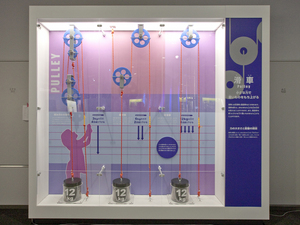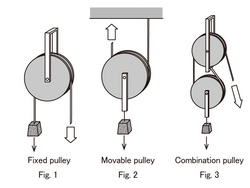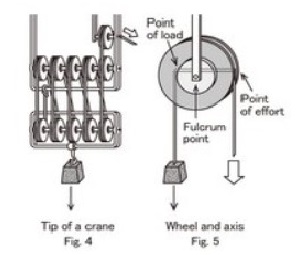Nagoya City Science Museum
TOP > Exhibition Guide > Keyword Search > Starting with "M" > machine > Pulley
Pulley

Purpose of Exhibition
A pulley has a feature which consists of a disk that has an axis in the center. The disk often has ditches along the circumference and a rope is hung for use. It is a machine which changes the direction of force and can lift up heavy loads with a small force.
The purpose of this exhibition is to help you understand more deeply the way pulleys operate.


Additional Knowledge
The simplest pulleys are a fixed pulley and a movable pulley. Both of them are often used together. We would like to explain by showing the examples of a simple fixed pulley, a movable pulley and a combination of these two pulleys.
[Fixed Pulley and Movable Pulley]
A fixed pulley is fixed and is used for changing the direction of force. When hauling water out of a well, you lift up a tub filled with water to the surface as you pull up the rope (Figure 1). On the other hand, in a movable pulley, one side of the rope is fixed and a heavy load is also fixed on the pulley. When you pull the side of the rope which is not fixed, you can lift the heavy load up. In this case, you can lift the load with only half the force of the actual load weight. Although only half the force is required, you need to pull up a length of rope twice as long (the height) while lifting the heavy load (Figure 2).
Work equals force times distance. Both the work, which affects a movable pulley, and the work of the resulting heavy load remains steady. This is called the law of conservation of energy and is a basic principle of dynamics.
[Combination of Fixed Pulley and the Movable Pulley]
It is a very convenient to know that a movable pulley enables you to lift up a heavy load using half its weight. However, it is a little inconvenient that you have to apply the force to the upper direction. Therefore, the secret, which changes the upward force to a downward force with a pulley, was developed and applied (Figure 3).
[Tip of Climbing Crane]
A combination pulley is used on the tip of a crane which lifts a heavy load. The inside of the right upper part of a hook is made like figure 4. By combining a fixed pulley and a movable pulley, it reduces the lifting power one tenth.
[Wheel and axle]
A wheel and axis is made by putting together a big and small pulley of different diameters. For instance, when the proportion of the diameter is 1:2, even if a wheel and axis is used like a fixed pulley, a heavy load is pulled up using only half of its force (Figure 5). In figure 5, a lever principle can be applied by considering that the axis is the fulcrum point, A is the point of load, and B is the point of effort. From this, you can calcuate how strong the force at the point of effort is.
Article by Koichi Mabuchi, Curator
